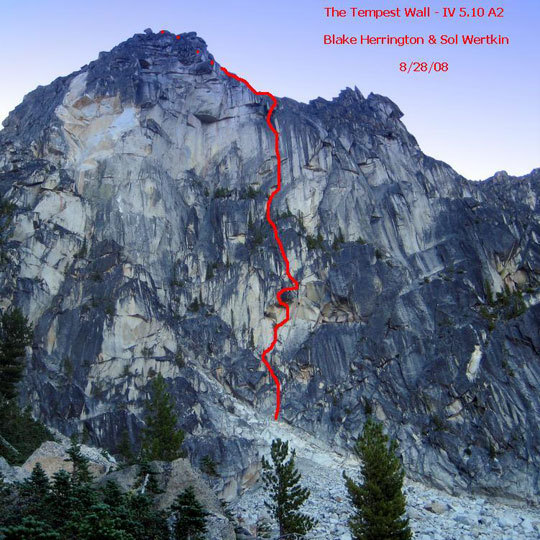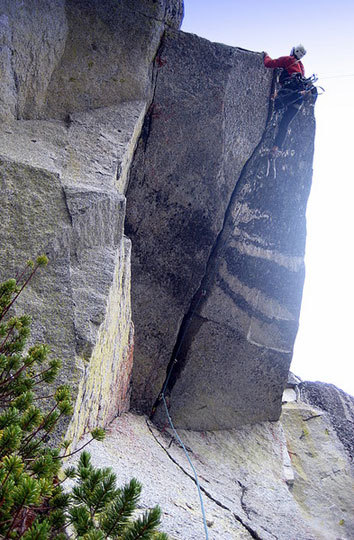
The Tempest Wall (IV 5.10 A2), Colchuck Balanced Rock, Enchantments, Cascades, Washington, established by Blake Herrington and Sol Wertkin on August 28, 2008. Poor weather and the 25′ roof documented in the image below forced the pair to “get creative in a hurry” on the ascent. The roof awaits a free ascent; “the local 5.13 hardmen are already getting psyched for a repeat or FFA when the weather improves,” Herrington said. [Photo] Blake Herrington
Forced to abandon our long-planned Cascades objective due to heavy rainstorms off the coast, my partner Sol Wertkin and I looked eastward, toward the rain-shadowed Enchantments area of the range. Unlike much of the northwest, this area of peaks and plateaus outside the faux-Bavarian village of Leavenworth holds solid rock and fairly dependable forecasts. We hoped these foreign luxuries wouldn’t remove all elements of adventure from the trip. Recounting the likely new possibilities in the area, I recalled a trip earlier in the summer up the hallowed West Face (IV 5.12a) of Colchuck Balanced Rock (CBR). While approaching the base of the route, I’d noticed a long line of clean roofs that blocked access to the immaculate and unclimbed face above. The largest of these roofs appeared split by a solid hand crack, jutting straight out of the wall for 25 feet, and overhanging the face below.

Wertkin aiding through the large roof on The Tempest Wall. [Photo] Blake Herrington
We reached the base of the peak with a full aid rack on the afternoon of August 27, and set out to fix a pitch or two before dark. Free climbing up to 5.10 and a few A0 moves brought us to a cramped belay sheltered below the roof. Leading this pitch, I didn’t realize that the weather had begun to worsen. Massive overhangs above kept me dry while Sol patiently belayed in the rain. We fixed our lines and found dry refuge among the overhanging boulders below the peak.
The morning of the 28th began with an early and disappointing start, as the predicted clearing had not occurred and all the peaks remained obscured in clouds. After ascending our fixed lines I belayed Sol as through the roof pitch, a section of climbing that actually ended slightly below where it had begun. The crack’s sustained 2″ width should make it an excellent contender for being freed, but with only two cams in that size, we were forced to get creative in a hurry. I fumbled my way out the roof, becoming more familiar and comfortable with the aid system as I moved out across space. The next pitches consisted of 5.9++ free climbing up a flake and long dihedral, eventually leading to blocky terrain and a ledge below the streaked headwall. The west-facing nature of the face gave us a great view of ominous sheets of mist and rain coursing toward us from the Pacific.
The cracks and seams we had seen from below turned out to be larger than expected, and the headwall went in a few short pitches of straightforward aid and free climbing. Once cleaned, this section should be fantastic and sustained 5.11 crack climbing. Darkness fell during on the final pitch and Sol took fired up his headlamp for the lead, resulting in a triumphant holler and heel hook as he crested onto easier ground. From here we found 500′ of star-lit simulclimbing on mid-fifth-class ground to the summit. We were meteorologicaly inspired to name our route The Tempest, and we were thrilled to have climbed such an excellent new route while rain and snow was slamming much of the range.